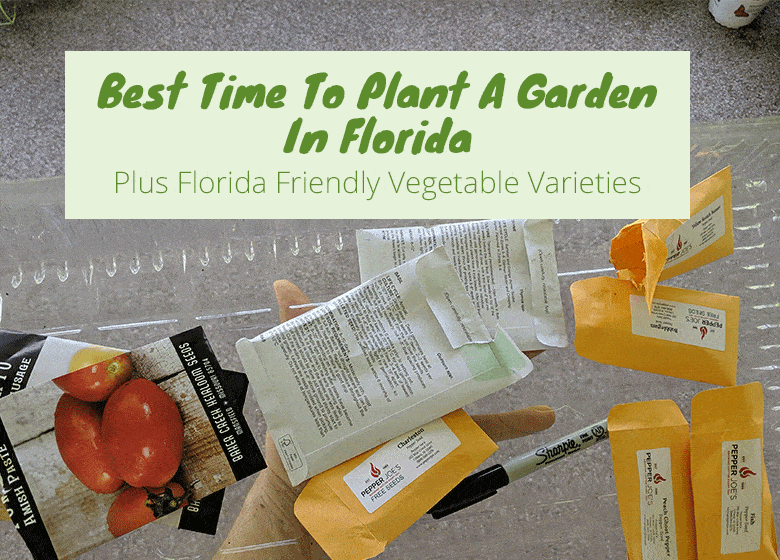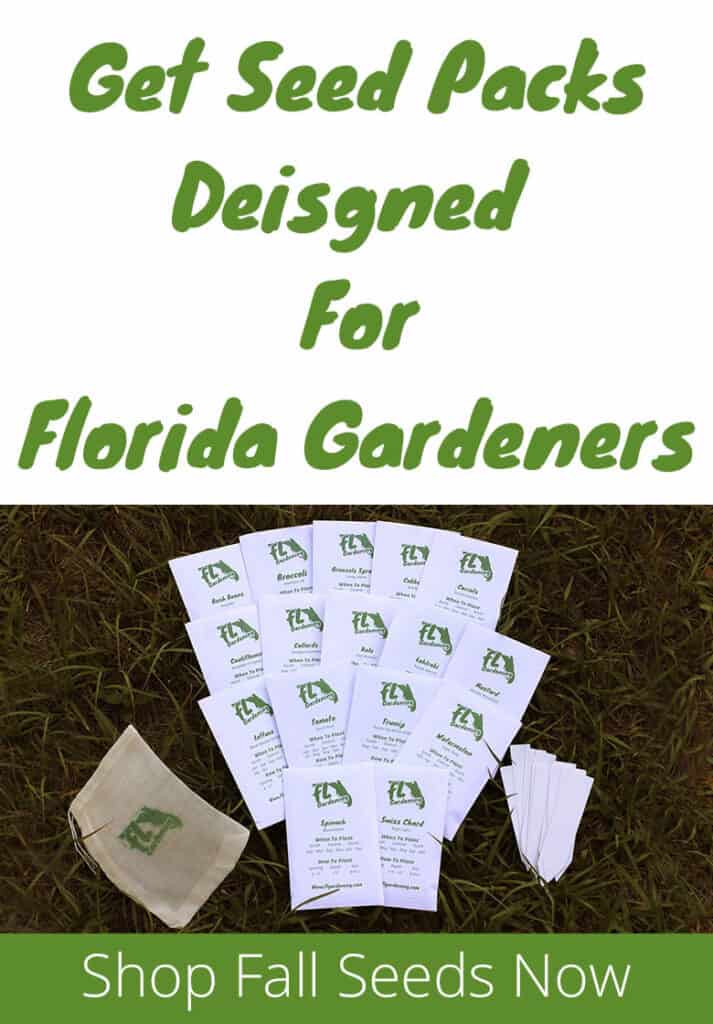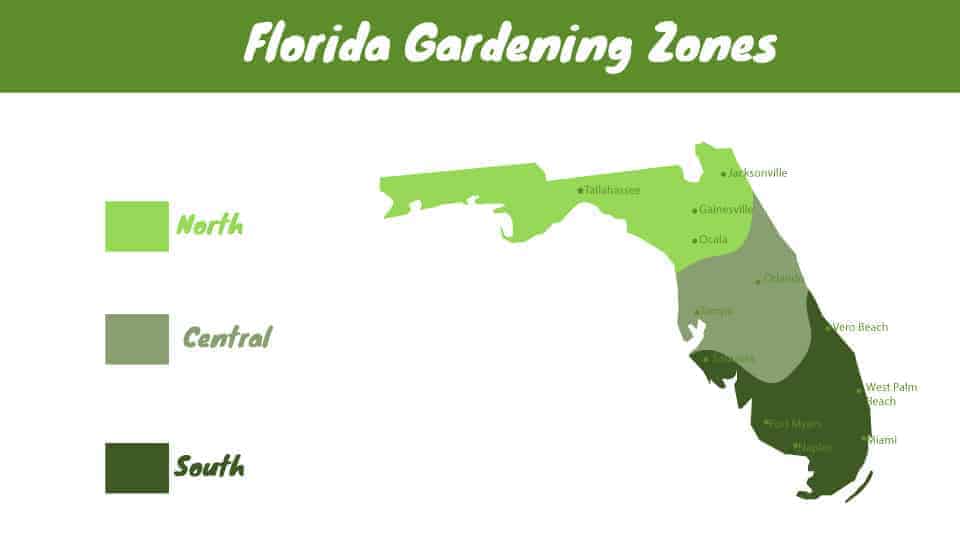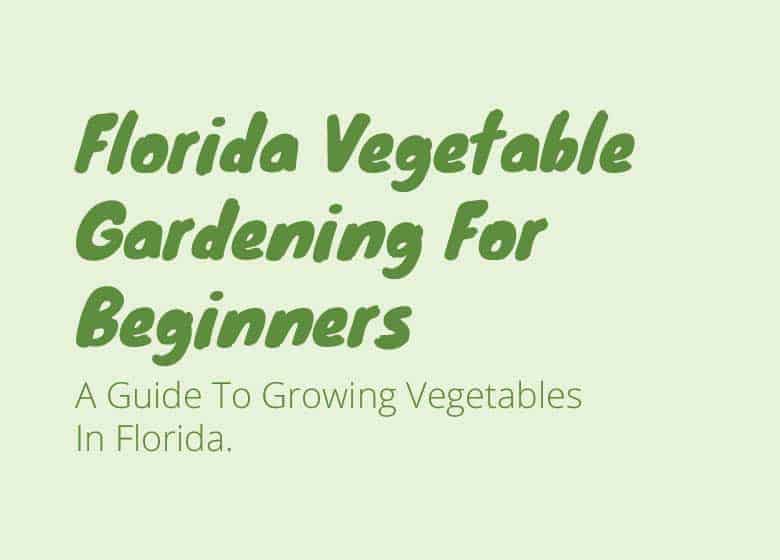
What is the best time to start a garden in Florida?
The best time to plant and start a vegetable garden in Florida is usually in September and also again in March. The exact timing will vary depending on where you are in the state and what you want to plant. In Florida, we have two main growing seasons, in the Fall and in the Spring.
If you want to plant things like Broccoli, Cabbage, Kale, and spinach the best time to plant in Florida is in the fall time. For things like Cantaloupe, Corn, Peppers, and Okra the ideal time is spring. There are a few vegetables that will grow outside of these growing windows. Continue reading for charts with planting times for specific vegetables and areas of the state.

What Area Of Florida Do You Live In?
Florida is a really long state. We actually have 7 different Usda agricultural zones in our state (8a – 11a). Northern Florida experiences regular freezes and south Florida is damn near a tropical paradise.
The part of the state that you live in will drastically change your planting times for certain vegetables. I like to keep things simple when it comes to breaking down parts of the state. I like to think in North, Central, and South instead of zone 8b.

Cities from Jacksonville down to Ocala fall into north Florida. While cities like Orlando and Tampa are classified as central Florida. South Florida is all of Florida below state road 70, this includes cities like Miami and West Palm beach.
When To Plant Vegetables In Florida
Use the chart below based on your location to determine your ideal planting times for lots of common vegetables in Florida.
| Vegetable | North Florida | Central Florida | South Florida |
| Beans | Mar-Apr & Aug-Sep | Feb-Apr & Aug-Sep | Sep – Apr |
| Beets | Aug – Feb | Sep – Feb | Oct – Jan |
| Broccoli | Aug – Feb | Sep – Feb | Oct – Jan |
| Brussel Sprouts | Aug – Feb | Sep – Feb | Oct – Jan |
| Cabbage | Aug – Feb | Sep – Feb | Sep – Jan |
| Carrots | Aug – Mar | Aug – Mar | Sep – Mar |
| Cauliflower | Aug – Feb | Sep – Feb | Sep – Jan |
| Collards | Anytime | Anytime | Anytime |
| Corn | Feb – Apr | Jan – Apr | Oct – Mar |
| Cucumber | Feb – Apr & Jul – Aug | Jan – Mar & Sep | Sep – Feb |
| Eggplant | Feb – Mar & Aug | Jan – Feb & Aug – Sep | Aug – Feb |
| Kale | Aug – Feb | Sep – Feb | Sep – Jan |
| Kohlrabi | Sep – Mar | Oct – Mar | Oct – Feb |
| Lettuce | Jen – Feb & Sep – Oct | Sep – Feb | Sep – Feb |
| Mustard | Aug – Feb | Sep – Feb | Sep – Jan |
| Okra | Mar – Jun | Feb – Aug | Jan – Mar & Aug – Oct |
| Onion | Sep – Mar | Aug – Feb | Sep – Mar |
| Peas (Southern) | Mar – July | Feb – Aug | Sep – Apr |
| Peas (Snow) | Jan – Mar | Nov – Feb | Nov – Feb |
| Peppers | Feb – Mar & July – Aug | Jan – Mar & Aug – Sep | Aug – Feb |
| Potato (Irish) | Jan – Feb | Nov – Feb | Oct – Jan |
| Potato (Sweet) | Mar – Jun | Feb – Jun | Dec – Sep |
| Pumpkin | July | July | Aug |
| Radish | Sep – Mar | Sep e Mar | Oct – Mar |
| Spinach | Sep – Mar | Sep – Mar | Oct – Feb |
| Squash | Feb – Apr & Aug – Sep | Jan – Apr & Aug – Sep | Aug – Mar |
| Swiss Chard | Sep – May | Sep – May | Sep – Mar |
| Tomato | Feb – Apr & Jul – Aug | Jan – Feb & Aug – Sep | Aug – Feb |
| Turnip | Aug – Feb | Sep – Feb | Sep – Jan |
The above dates are just guidelines. The planting windows will vary depending on the year. Some years are colder than others while other years are hotter than others. You will need to use your best judgment when it comes to planting your seeds.
The dates above have been chosen because they give the ideal stretches of weather for most vegetables. The best weather for vegetables will be frost and freeze few and free from our hellish summer heat.
Florida Friendly Vegetable Varieties
Look at the chart below for Florida’s recommended vegetable varieties. This is not an all-inclusive list. I’m sure there are some varieties of vegetables that grow well that are not on this list.
I’m always trying new varieties of vegetables and I encourage everybody to do the same. We will never know if we don’t try.
| Vegetable | Variety |
| Arugula | Astro, Speedy |
| Beans, Bush | Bush Blue Lake, Cherokee Wax, Contender, Roma II |
| Beans, Pole | McCaslan, Kentucky Wonder, Blue Lake |
| Beans, Lima | Dixie Butterpea, Early Thorogreen, Fordhook 242 |
| Bans, Shell | Black Bean, Garbanzo, Navy, Pinto, Red Kidney |
| Beets | Cylindra, Detroit Dark Red, Early Wonder, Tall Top |
| Broccoli | Early Green, Packman, Waltham |
| Brussels | Jade Cross, Long Island Improved |
| Cabbage | Copenhagen Market, Savoy, Red Acre, Wakefield |
| Cantaloupe | Ambrosia, Bush star, Honey Rock |
| Carrot | Chantenay, Danvers, Impertor, Nantes |
| Cauliflower | Brocoverde, Snowball |
| Celery | Utah |
| Collard | Georgia Southern, Morris Heading, Vates |
| Corn | Early Sunglow, Sweet Riser, How Sweet It Is, Silver Queen |
| Cucumber,Slicers | Ashley, Marketmore 76, Poinsett, Sweet Success |
| Cucumber, Pickle-rs | Boston, Eureka |
| Eggplant | Black Beauty, Cloud Nine, Dusky Long, Ichiban |
| Kale | Lacinato, Red Russin, Winterbor |
| Kohlrabi | Early White Vienna, Purple Vienna |
| Lettuce, Butter | Ermosa, Bibb, Tom Thumb, Buttercrunch |
| Lettuce, Looseleaf | Black Seeded Simpson, Red Sails, Oak Leaf, Salad Bo-wl |
| Lettuce, Romaine | Parris Island Cos, Outredgeous |
| Mustard | Florida Broad Leaf, Giant Red, Southern Giant Curled |
| Okra | Annie Oakley II, Cajun Delight, Clemson Spineless, Emerald |
| Onion | Chippolini White, Matador Shallot, Granex, White Libson |
| Pea, English | Green Arrow, Oregon Sugarpod II, Sugar Snap, Wando |
| Pea, Southern | California Blackeye No 5, Hull, Pinkeye Purple, Texas Cream |
| Peppers, Sweet | Big Bertha, California Wonder, Sweet Banana |
| Pepper, Hot | Ancho, Cayenne, Ghost Peper, Habanero, Jalapeno |
| Potato | French Fingerlings, Red Pontiac, Yukon Gold |
| Spinach | Bloomsdale Longstanding |
| Squash, Summer | Crookneck, Early White Scallop |
| Squash, Winter | Spaghetti, Early Butternut, Waltham |
| Squash, Zucchini | Black Beauty, Cocozelle, Spineless Beauty |
| Sweet potato | Beauregard |
| Swiss Chard | Bright Lights, Fordhook Giant, Red Ruby |
| Tomato, Determinat-e | Celebrity, Tasti-Lee, Floragold |
| Tomato, Indetermin-ate | Better Boy, Bonnies Best, Everglades, Sweet 100 |
| Turnip | Purple Top White Globe, Seven Top |
| Watermelon | Charleston Grey 133, Crimson Sweet, Sugar Baby |
Quick Tip: If you're in to growing tomatoes, I would recomend growing everglades tomatoes. If you have never grown the, before they are the easiest tomato that you will ever grow in Florida.
A Few Gardening Basics
There are a few vegetable gardening basics that you should know that will get you started on the right foot.
- Vegetable gardens need at least 8 hours of sun. Be sure to pick a spot that gets at least this. I’ve found that plants like early morning sun better than late day sun.
- Florida has a different planting pattern compared to most of the United States. Be sure to follow the timing guideline posted above.
- Florida has soil that is mostly sandy. This is not ideal for most vegetables. Be sure to add compost and a thick layer of mulch at the very least if you are planting directly into the ground.
- Choose the appropriate fertilizer. If growing leafy greens, choose something that is nitrogen focused. If growing something that produces a fruit fertilize with a more well-balanced blend.
- Water regularly and check for pests and diseases.
- The best approach to pest control is planting a diverse garden. However, sometimes chemical control is necessary. Neem oil is a great organic option.
- Harvest when things are ripe. Don’t wait too long. Bugs, birds, and critters are looking to eat your plants just as much as you are.
Starting A Vegetable Garden In Florida
The first step to planting a vegetable garden is knowing what part of the state you live in. This will alter the timing. After you know which part of the state you fall into, use the planting guideline above to determine the best time to plant a garden in Florida.
Choose a variety of vegetables off of the list above. You can get lot of high-quality seeds from places like UFseeds and Johnny Seeds. Both are trusted seed companies in my book.
For A More In-Depth Guide On Florida Vegetable Gardening Check This Out



